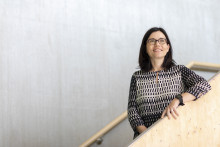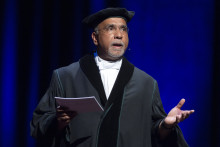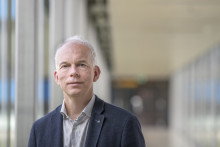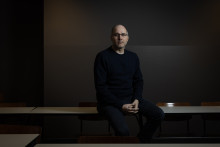‘I’ve loved technology since I was little,’ says the scientist. ‘First I wanted to be an astronaut, but I would often get car sick, so I didn’t think going into space would be the best plan. I started researching other ways I could work for NASA. I noticed they worked a lot with small devices and decided I wanted to move in that direction. I looked up degrees that focused on miniaturization and chips and picked “Telecommunications Engineering” at Universidad Politécnica de Madrid. At least I wanted to make things that would be sent to space.’ That wish came true later on.
The eye-opener
First came IBM in California. ‘That’s where all my plans changed,’ says Sonia García Blanco, describing how conducting her Master’s research at this big American technology company inspired her to pursue an academic career. ‘It was like paradise. We were working on modifying materials for hard discs. All my colleagues were so smart and worked with so many cool devices. I wanted to get their job, so I asked them how I could achieve that. They told me I first needed a PhD and then become a postdoc. I got excited and began searching for PhD positions.’
Her time at IBM was an eye-opener in several ways. ‘It was the first time I noticed that being a woman in science is an issue,’ says the researcher. ‘I got invited to lunch for women and there were only ten of us there. Yes, all my direct colleagues were men, but I didn’t think about it. It wasn’t a challenge. Then one female postdoc asked me if I was planning to have kids. I answered that I was and she was quite shocked. For her, career in research and having children were completely incompatible.’
'For her, career in research and having children were completely incompatible.'
Braveheart
Sonia García Blanco didn’t get discouraged. She took a map, choosing where to settle down for her PhD research. She had just watched Braveheart and thought Scotland looked nice, and so she applied for positions in Edinburgh and Glasgow. She got accepted to both and also elsewhere, but picked Glasgow ‘even though the other offers were better’. Why? ‘I have a theory,’ she answers with a smile. ‘I had to go to Glasgow to meet my husband. He was working at the university. It was destiny.’ It was also an interesting research project, of course. On integrated optical biosensors. ‘That was when I entered the field of optical sciences.’
Sonia García Blanco in a nutshell:
2015 ERC Consolidator Grant
2015 Associate Professor of Integrated Optical Systems at the UT
2010 Assistant Professor in Optical Sciences at the UT
2005 – 2010 Microfabrication and microoptics researcher at company INO (Quebec)
2003 – 2005 Postdoctoral fellow at the University of Toronto
2002 PhD degree in Photonics at the University of Glasgow
1999 Master’s degree in ‘Telecommunications Engineering’ at Universidad Politécnica de Madrid
1998 - 1999 Student researcher at IBM Almaden Research Center, Silicon Valley
The scientist has remained faithful to one field – but not to one location. After obtaining her doctoral degree in Glasgow, she moved to Toronto for her postdoc research. Not for long, though. Company INO in Quebec soon offered her a job as a scientific staff member. ‘It was a very hands-on and varied job. I got to work on many projects for space applications for the Canadian Space Agency. One of my detectors for infrared satellites went to space.’ Hence the childhood dream came true. And it was time to move on. ‘I enjoyed my time in industry, but I was always given the project. I wanted to influence the direction I went in and I also wanted to teach. So I began looking for academic positions.’

Doubts and successes
She soon found one at the University of Twente. ‘I love it here. There is a big scientific community and the local facilities are great. Our clean room is the best I’ve ever seen,’ says García Blanco, but adds: ‘It was hard at the beginning. Moving from industry to academia, moving to another country. It took a while for me to “infiltrate” the system. I didn’t know anyone in academic circles and after six years without any publications, it’s hard to catch up. People didn’t trust me because I used to work in industry.’ She got ‘saved’ by the Marie-Curie Integration Grant. ‘That was a great starting point. It shows that someone does have trust in you.’
That was the first, but not the last prestigious grant that García Blanco received. In 2015, she was awarded the ERC Consolidator Grant worth two million euros for her project RENOS (Rare-earth doped novel on-chip sources). The project aims to develop compact on-chip laser sources for uses in optical sensing, spectroscopy, metrology and telecommunications. ‘Actually, many people told me I must have gotten the grant because I was a woman,’ mentions the researcher. ‘Of course these grants are based on the excellence of your work, but if you’re a woman, people somehow question your success. I would say I was in disadvantage, if anything. I was very pregnant during the ERC grant interview, it was the day before I started my maternity leave, and so I was worried they would not even consider me.’
Making a difference
Now with two young children, Sonia García Blanco is on the tenure track and continues to be one of the leading experts in the field of Integrated Optics. Her research focuses on Active Nanophotonic Devices: development of novel on-chip active devices (lasers and amplifiers). In simpler words, she works on miniaturization of optical devices on chips. ‘I believe our research can do something really relevant for the society. There are so many possible applications. Our chips could go virtually anywhere. For instance, I work on projects with medical applications that could be used for an early detection of diseases,’ says the scientist.
'I want my technology to make a real difference in the world.'
As an exam'I want my technology to make a real difference in the world.'ple, the Associate Professor mentions project GLAM (Glass-Laser Multiplexed Biosensors), that could offer groundbreaking technology for detection of cancer. It aims to develop a new diagnostic tool to detect biomarkers from biofluids obtained in a non-invasive manner, focusing on genitourinary cancers. ‘In essence, we are working on an optical laser on a chip that could be used in any doctor’s office. The doctor could simply put a drop of urine in the device and it would show concentration of cancer biomarkers, possibly detecting cancer at a very early stage,’ explains the researcher. ‘If it works, it would be absolutely amazing. It would offer a much cheaper alternative to current technology. I would really love to see our chips enter the market. Bridge the gap between research and application and make it really useful. I want my technology to make a real difference in the world.’

A word of advice
The scientist’s passion for her job is unmistakable and pure. Her face lights up when she talks of her research. ‘I love developing technology. I wake up every day and I’m happy to go to work,’ she confirms. Is Twente the place where she will finally settle down forever? ‘Possibly. I enjoy my research now, but you never know what future holds.’
Regardless the future, the present is looking bright for this young academic. It’s the past that led her here. Is there anything she would have done differently? ‘When I was making big decisions, perhaps I should have considered academic requirements a bit more, not decide based on somewhat random parameters. Maybe choosing to go to Glasgow because I liked Braveheart wasn’t the greatest reason. But on the other hand, then I wouldn’t have had the experience. And an advice I would give to my younger self? That would be something that I actually did. I would say “Do what you like and go for it!”’
You can also find the interview in our latest Science & Technology Magazine. Grab a printed copy at the campus or see the full magazine online.







